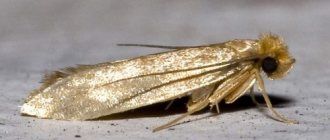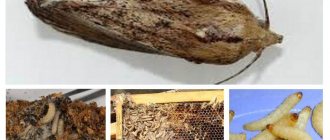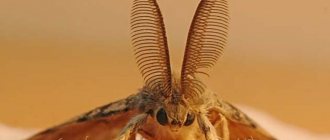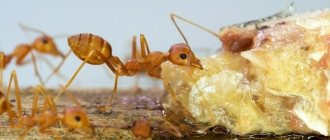A moth's lip is not stupid. She is not interested in cheap synthetics - give her fur. Silk and wool, natural and expensive, will also work. If she’s really hungry, she won’t disdain feathers and cotton. How to protect your most valuable things from an insatiable pest?
To win the war against clothes moths, you need to carefully study its preferences and find vulnerabilities, and then deprive it of pleasures and strike where it hurts the most. Only then will it be possible to get rid of the voracious insect once and for all.
Who eats our clothes
The clothes moth (also known as the house moth) is a small butterfly with golden wings with fringed edges. However, she is not the main enemy of our things. Irreparable damage to the wardrobe is caused by its larva - a transparent white caterpillar up to 1 cm long. The caterpillar is very lazy, inactive, but when it needs to find food for itself, it begins to move.
When you see a moth flying around the house, you don’t even have to run after it, trying to swat it. The fact is that only males or females who have already laid eggs fly. They will no longer bring you harm, and they will soon die themselves. You need to hunt for their eggs and larvae.
How moths get into our houses and apartments
The easiest way is through an open window or door. However, clothes moths are also capable of entering a home through a narrow gap. The flying butterfly finds suitable conditions for reproduction and food and lays eggs there.
If you brought an antique or simply used sofa from somewhere, it is quite possible that there were already eggs or moth larvae in its upholstery. The same goes for used clothes.
Clothes moth larvae can come to us, although rarely, through the fur of domestic animals.
Why is the parasite dangerous?
Moths do not bite people or domestic animals and are not carriers of diseases. It causes significant harm to humans, as it spoils food supplies, clothing, and household utensils in large quantities.
Favorite “dishes” of insects:
cereals, flour, pasta supplies; cookies, crackers; nuts, seeds.
With pleasure, the moth eats available supplies of sweets (for example, candy). In places where it settles, there is a sticky web and microscopic scales. Worm larvae, with their powerful jaws, are able to gnaw through entire tunnels in food supplies, simultaneously filling them with their own excrement.
Read about how to clean carpet without a vacuum cleaner without removing it from the floor at this address.
The moth causes severe damage to things in which it manages to lay eggs. It can be:
carpeting, upholstery of upholstered furniture made from natural fabrics (especially those with a high wool content); woolen sweaters, jackets, socks, scarves, hats, mittens, down scarves; fur coats, jackets, hats.
If the reproduction of moths is not stopped in time, a horde of larvae can be turned into a fur coat completely unusable during the summer season. The larvae eat away entire bald spots on fur, make holes in woolen materials, and leave holes in sofas and armchairs.
The larva of a food moth will mature in 5 weeks, and a clothes moth in 3 months before turning into a cocoon pupa, from which a gray velvety butterfly moth will subsequently hatch. The butterfly will no longer eat food and clothing, but during its short three-week life it will have time to lay a new batch of eggs.
What does a moth like?
Let's deal with the preferences of house moths.
- Clothes moths love dirt. If there are traces of sweat on your clothes, for example, it will go there first.
- She feels great in conditions of high humidity. If the closet is damp and cool, expect her to visit.
- Clothes moths feed on natural fabrics (wool, silk, cashmere, cotton, etc.) and furs. Therefore, pest larvae gnaw not only clothes, but also any objects made from the mentioned materials: carpets, blankets, upholstery, fabric spines of books, stuffed birds (she also loves feathers), etc.
What does it look like
Moths, whose larvae eat things made from natural fabrics, have a number of differences from other clothing pests.
The appearance characteristics of this insect are as follows:
- The body length of the parasite is no more than seven mm, the length of the wings is one and a half cm.
- The color of the wings is golden, and there are reddish bristly hairs on the head.
- A developed oral apparatus is present exclusively in larvae; adult butterflies, whose total lifespan is no more than seven days, do not need food.
- Larval development occurs over several weeks. Under moderate temperature conditions, the development cycle is about 200 days.
- Female butterflies do not fly, although their wings are developed.
Knowing what moths that eat clothes look like, you can promptly identify the pest and take measures to destroy it, which will avoid damage to textiles. It is important to determine the species of the insect, since the methods of getting rid of certain varieties have some differences.
What are house moths and their larvae afraid of?
Now let’s try to understand what the moth is trying to avoid in every possible way.
- Clothes moth caterpillars are afraid of high temperatures (above 60-70°C).
- Oddly enough, she doesn’t like low temperatures either. It cannot survive freezing, for example, in the freezer compartment of a refrigerator.
- Ultraviolet radiation, both natural (sun rays) and artificial (ultraviolet lamps), has a detrimental effect on moth eggs and larvae.
- She can't stand some smells. For example, our grandmothers noticed that moths do not live where mothballs lie. Therefore, “aromatherapy” can be used as a preventive measure to scare away an unwanted guest from your closet.
Folk remedies for moths
Most folk remedies do not fight moths, but simply scare them away, depriving them of the desire to settle on your territory, which is also not bad.
- Place bunches of dried lavender, tansy, wormwood or mint in your closet. You can make bags of dried grass and place them in your fur coat pockets. These smells will repel moths from your wardrobe.
- Clothes moths also do not like the smell of dried orange peels. Place the crusts between woolen sweaters and silk blouses - moths will avoid them.
- Place geraniums on the windowsill. Its pungent smell will force moths to leave your property.
- Essential oils – lavender and fir – are also considered good repellents. If you don't have a special aroma lamp, just saturate small pieces of fabric with oil and put them in the closet. Don't forget to update the scent from time to time.
All of the above remedies will certainly repel moths from your home. What to do if she has already moved in with you? There is only one answer - fight.
- Thoroughly clean all clothing made from natural materials with a brush or vacuum cleaner.
- On a hot summer day, take it outside and dry it. Under the influence of ultraviolet light, moth larvae, if they were able to survive the cleaning, hiding in the folds, will simply die.
- In winter or during the cool season, when there is no sun, freezing will help destroy moth larvae. Take the clothes out into the cold or, if the item is small, simply wrap it in a plastic bag and put it in the freezer for several hours. Low temperatures will kill harmful larvae.
Chemical repellents for moths
Chemicals are also used to combat moths. Almost all of these insecticides are based on pyrethroids, poisons that have a nerve-paralytic effect. They are made in the form of tablets, aerosols, insect traps, etc.
- One of the most powerful poisons is dichlorvos (many drugs marketed under this name are not actually dichlorvos). They need to treat all clothing where house moth larvae were found. Do not forget to follow the safety instructions written on the packaging. For prevention, Dichlorvos and other aerosols (for example, Moskitol, Armol, Taiga, Raptor, etc.) should not be used, because their smell quickly disappears and it will not cause any harm to insects - but it can do you and your household.
- Preparations that fight the larvae and adults of clothes moths are also moth plates - small cardboards impregnated with substances poisonous to insects: Antimol, Doctor Claus, etc. They are laid out in places where moths and their larvae live on the upper shelves, because the smell descends from top to bottom. Once every few months, when the effect of the drug decreases, the plates are replaced with new ones.
- Many drugs against indoor moths (tablets and balls) are used as a prophylactic agent: they repel the insect. There are also many drugs that contain the old, but not so good, naphthalene. The poison that naphthalene releases in large quantities can cause poisoning and adversely affect the functioning of the liver, pancreas and other organs. Therefore, it is dangerous to use it in places where there are children.
- Sections are also used as repellents - products with a repellent odor are in a special case, which can be easily attached to the wall of the closet (adhesive tape on the bottom) or hung by a hook on a clothes rail.
We save products
Food moths prefer to settle in food bags. If you don't want to spend money feeding ravenous maggots, don't turn your kitchen into a strategic food storage area. There are almost no people left who remember the siege of Leningrad and the wartime famine; store shelves have long been filled with all kinds of products, but some pensioners keep bags of flour, cereals, and dried fruits at home. Grandmothers are afraid of inflation, rising prices, a bad year and who knows what misfortunes and independently attract pests into the apartment.
You need to understand that it is impossible to stock up for a lifetime, and a bag of flour purchased at low prices will spoil and be thrown into the trash. It is not known from what sources and at what time information publications received advice to sort out cereals spoiled by caterpillars and fry them in the oven. This should not be done: insect larvae and eggs that get into food can cause poisoning. It is better to buy food in small portions and store them correctly, then you won’t have to throw anything away. If you notice several grains in a bag, fastened together by a web, you should know that a moth larva has entered there and is preparing food for transportation to another place. The product is no longer suitable for consumption; if it’s a shame to throw it away, give it to the birds.
Pour all food supplies from bags into jars with airtight lids. Wash the inside of kitchen cabinets with a solution of soda or vinegar; use the same mixture to treat all cracks and gaps in furniture and building structures.
Adult moths do not eat, but they do need plenty of water to lay eggs. Put the plumbing in order so that there are no leaking pipes and taps in the apartment. Empty water from trays in dish drainers and do not leave glasses and cups with unfinished liquid on the table. To prevent moths from visiting you from your neighbors, tighten the ventilation grilles with a dense mesh.
There is no need to stock up on products that are attractive to moths, but you can purchase spices that the pest does not like in large quantities. If you decide to store cereals and flour in bags, put a few cloves of garlic in there, and the parasites will not touch your supplies. If you don't like the pungent garlic smell that comes from your food, you can repel pests with a different scent.
The butterfly will not lay eggs where there is a smell:
- bay leaf;
- black allspice;
- cloves;
- walnut leaves.
Preventing moths
What to do to prevent moths from appearing in the house? You need to follow some rules:
- Before storing clothes in a closet, be sure to wash, clean, or dry-clean them.
- Store seasonal clothing in special cases. Place a fur coat, sweater, hat, etc. in the case, add an anti-moth remedy (folk or chemical) and zip it up.
- From time to time, vacuum cabinets (pay attention to every shelf and corner), upholstered furniture, floors and carpets. Don’t forget to wet-clean storage areas: first wash each surface with water and detergent, dry, and then wipe everything with vinegar. Moths cannot stand its smell.
- House moths also do not like printing ink. Therefore, stuff newspapers into your shoes during storage. This will keep your boots and shoes safe.
- Conduct a thorough inspection of your wardrobe several times a season. Air out your clothes and closets more often. Clothes moths almost never grow on clothes that are constantly used. But she loves the one that lies idle for a long time very much.
Moths are a dangerous enemy. However, it is still possible to defeat her. Order, cleanliness, repellents, insect control products - and victory will be on your side. How do you fight this fur lover?











